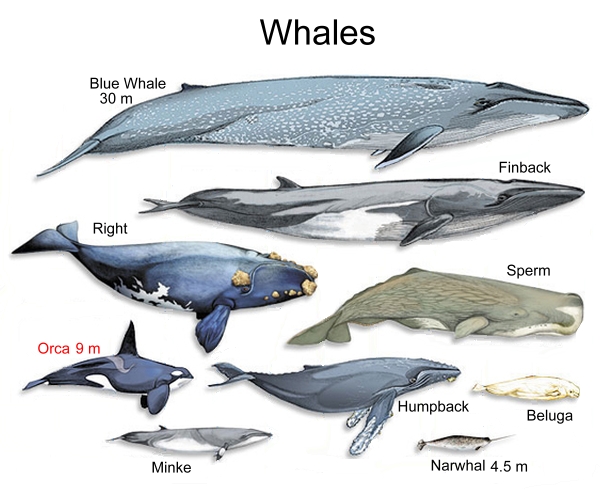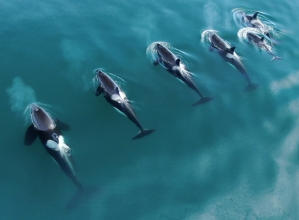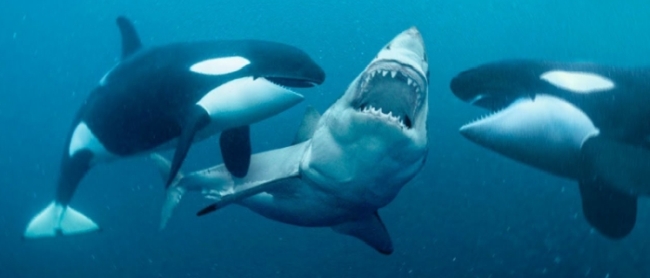 Orcas (also known as killer whales) are marine mammals and apex predators. They are the largest member of the dolphin family. Killer whales are easy to identify by their striking colouration: jet black on top and pure white below, with white patches behind each eye, up each flank, and behind the dorsal fin. Orcas are smaller in size relative to other whales, but their tall dorsal fin makes them easy to identify.   Known to be highly intelligent, orcas are among the few nonhuman animals to be able to recognize themselves in a mirror. They can swim at speeds estimated at over forty kilometers per hour, and are easily capable of catching prey, including most species of seals.
Known to be highly intelligent, orcas are among the few nonhuman animals to be able to recognize themselves in a mirror. They can swim at speeds estimated at over forty kilometers per hour, and are easily capable of catching prey, including most species of seals.
Killer whales, scientifically known as Orcinus orca, are, like all whales, mammals. They have an average life span in the wild of 50 - 80 years. Orcas can grow to be over 9 metres long, and weigh up to 5.5 tonnes. Orcas, like dolphins, can shut down one half of their brain and sleep with one eye open. This is to prevent them from drowning, as they still need to breathe oxygen from the surface.  Killer whales live in small groups called pods that number up to 40 individuals. Killer whale pods are extended families with matriarchal hierarchies led by older females.
Orcas hunt everything from fish to walruses, seals, sea lions,
penguins, squid, sea turtles, sharks, and even other kinds of whales. Echolocation is used by killer whales in feeding and communication. Killer whales live in small groups called pods that number up to 40 individuals. Killer whale pods are extended families with matriarchal hierarchies led by older females.
Orcas hunt everything from fish to walruses, seals, sea lions,
penguins, squid, sea turtles, sharks, and even other kinds of whales. Echolocation is used by killer whales in feeding and communication.
Despite the fact that orcas are powerful carnivores, there is no record of humans being killed by them in the wild.  Average-sized orcas may eat about 227 kilograms of food a day. Orcas have many hunting techniques, including bumping seals off ice floes. Orcas hunt together cooperatively, much like a pack of wolves. They work together to herd fish into a compact area so that they're easier to eat. They will also slap their tails on the water's surface, causing a wave to wash prey, such as penguins or sea lions, off ice floes and into the water. Sometimes a pod of whales will surround a larger animal, such as a bigger whale, and chase, bite, and wear it down until it tires and becomes a meal! Average-sized orcas may eat about 227 kilograms of food a day. Orcas have many hunting techniques, including bumping seals off ice floes. Orcas hunt together cooperatively, much like a pack of wolves. They work together to herd fish into a compact area so that they're easier to eat. They will also slap their tails on the water's surface, causing a wave to wash prey, such as penguins or sea lions, off ice floes and into the water. Sometimes a pod of whales will surround a larger animal, such as a bigger whale, and chase, bite, and wear it down until it tires and becomes a meal!
Orcas have about 45 teeth, each measuring about 7.6 centimeters long, that are shaped for ripping and tearing prey. Orcas don't chew their food; they can swallow seals and sea lions whole. Bigger prey is eaten in chunks. The colour pattern of orcas helps them sneak up on their prey; their backs are black, so animals like seals looking down on an orca from above, while on an ice floe, might not see it because the whale's dark back blends with the water below. Different populations of killer whales have specialized diets. A few populations of orcas specialize in eating sharks, particularly great white sharks. Orcas have been known to attack them, sometimes removing their livers with surgical precision. The reason that killer whales target the livers of sharks may be that they are full of oil and high in vitamins, as well being high in calories.  |